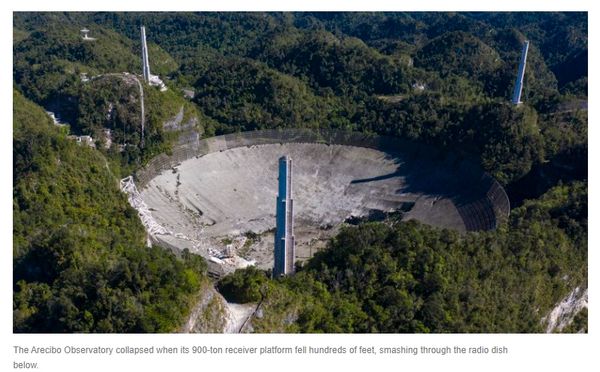The Arecibo Radio Telescope has collapsed
Dec 2, 2020 15:31:37 #
TriX wrote:
And now it is in jeopardy. NSF puts Arecibo Observatory on Chopping Block.As expected. The loss of a magnificent instrument that has done some great science - a sadness.
https://www.space.com/arecibo-radio-telescope-collapses
https://www.space.com/arecibo-radio-telescope-collapses
Dec 3, 2020 07:35:31 #
BBurns wrote:
And now it is in jeopardy. NSF puts Arecibo Observatory on Chopping Block.
I'm afraid it's beyond jeopardy now.
Dec 3, 2020 15:02:00 #
BBurns wrote:
And now it is in jeopardy. NSF puts Arecibo Observatory on Chopping Block.
Yes, safety considerations required taking down the cable-supported triangle housing the feed. But nature stepped in and did the job before anyone could get started trying to take it down in a controlled way. It collapsed Tuesday. No injuries reported.
It was a great place to work. I was there in the early '70s. The facility started as an astronomical receiver, as I recall, and was upgraded to a radar soon after that. It was used for ionospheric studies at UHF frequencies. They could make measurements of ionospheric densities, temperatures, and winds (and some composition measurements). I was involved in optical measurements of ionospheric processes and they extended the transmitter frequency down to around 5MHz for ionospheric modification experiments. We could watch the optical characteristics of the modifications.
There were a lot of graduate students that went through that place. One time I was there the grad students threw a party down in the town of Arecibo (on the coast). We went to the beach and had a few beers etc. A few people ventured out into the water. I was commiserating with them when they came back with sea urchin spines in their feet. About a week later the sea urchin spines started to work their way out of my feet.
One party lasted into the wee hours. I had a rental car, and I was staying on site at the observatory, about 12 miles into the mountains. I got in my rental car, which I had only driven during the day to go back to the observatory. Turned the ignition and the engine caught, no problem. Turned on the lights and the engine died. Quickly turned off the lights and the engine caught again. So it was an interesting drive back to the observatory on the winding mountain roads. Fortunately it was in the wee hours. I could get the car moving, turn on the lights for a second to see where I was, then turn them off for a few seconds to keep the car running. No traffic at that time of night, I made it back.
One trip we had a photometer that would look at the sky to observe the effects of the ionospheric modifications. As an optical instrument needs clear skies, we chose a location in the southwest part of the island that was basically a desert. We set the instrument up in a field and stayed in a local motel. That was when I learned that roosters do not crow at dawn and dusk. They crow any time they damn well please. I also learned that putting the legs of your bed into a can with some kerosene will keep the cockroaches from crawling onto your bed. It was an educational trip. I also learned that the desert area of Puerto Rico is not always like the clear desert skies you get in the US southwest desert areas. It rained for two weeks except for two days. The roads were all mud. On the nights when it wasn't raining we had trouble communicating with the observatory. It was a mile drive to the nearest telephone. It was a five mile drive to the nearest working telephone.
Dec 4, 2020 13:09:41 #
TriX wrote:
Here is a drone video of the collapse.As expected. The loss of a magnificent instrument that has done some great science - a sadness.
https://www.space.com/arecibo-radio-telescope-collapses
https://www.space.com/arecibo-radio-telescope-collapses
Arecibo Telescope Collapses, Ending 57-Year Run


Dec 4, 2020 13:42:22 #
The video didn't show up on my machine. The page was there and there was a space in the text for the video but it didn't load. Looked at the html and found this:
https://www.youtube.com/embed/T99REQhNlt4
https://www.youtube.com/embed/T99REQhNlt4
Dec 4, 2020 16:49:22 #
DirtFarmer wrote:
Yes, safety considerations required taking down th... (show quote)
Wow - didn’t know you had worked there - very interesting and personal story, thanks for posting.
Dec 4, 2020 22:11:18 #
Saw a video on youtube today. Can't remember the guy's name, but probably other people had access to the same source. There was actually a drone filming the tower where the first cables let loose . Ah - Scot Manley is his name! Not totally sober right now, but who's asking...?
Incredible footage of the cables giving way, and frame-by-frame analysis... Worth a watch!
Incredible footage of the cables giving way, and frame-by-frame analysis... Worth a watch!
If you want to reply, then register here. Registration is free and your account is created instantly, so you can post right away.



